城市化的利与弊英语作文
城市化的利于弊四级英语作文120词
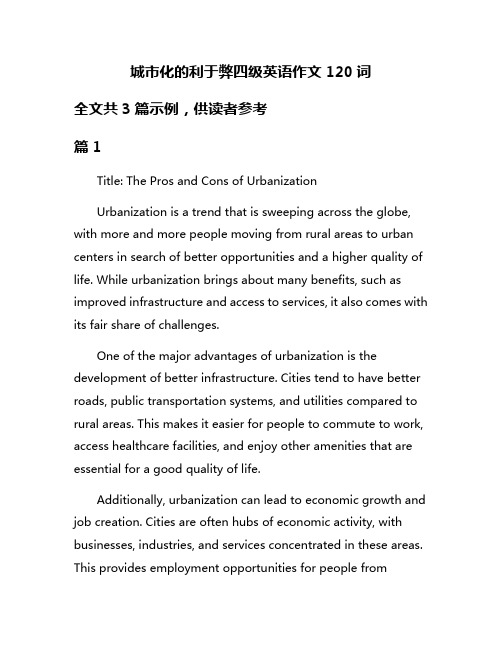
城市化的利于弊四级英语作文120词全文共3篇示例,供读者参考篇1Title: The Pros and Cons of UrbanizationUrbanization is a trend that is sweeping across the globe, with more and more people moving from rural areas to urban centers in search of better opportunities and a higher quality of life. While urbanization brings about many benefits, such as improved infrastructure and access to services, it also comes with its fair share of challenges.One of the major advantages of urbanization is the development of better infrastructure. Cities tend to have better roads, public transportation systems, and utilities compared to rural areas. This makes it easier for people to commute to work, access healthcare facilities, and enjoy other amenities that are essential for a good quality of life.Additionally, urbanization can lead to economic growth and job creation. Cities are often hubs of economic activity, with businesses, industries, and services concentrated in these areas. This provides employment opportunities for people fromdifferent walks of life, leading to increased incomes and a higher standard of living.Furthermore, urbanization can promote cultural exchange and diversity. Cities are melting pots of different cultures, languages, and traditions, creating a vibrant and dynamic environment where people can learn from each other and broaden their horizons.However, urbanization also has its downsides. One of the major challenges of urbanization is the strain it puts on infrastructure and resources. As more people move to cities, there is increased pressure on transportation, housing, and public services, leading to congestion, pollution, and other environmental issues.Moreover, urbanization can exacerbate social inequality. Cities often have pockets of poverty and deprivation, with some people living in slums or informal settlements without access to basic services such as clean water, sanitation, and healthcare. This can lead to social unrest and a sense of marginalization among the urban poor.In conclusion, urbanization is a double-edged sword with both advantages and disadvantages. While it brings about economic growth, job creation, and cultural exchange, it alsoposes challenges such as strain on infrastructure, environmental degradation, and social inequality. It is important for policymakers to address these challenges and ensure that urbanization is sustainable and inclusive for all members of society.篇2Advantages and Disadvantages of UrbanizationUrbanization refers to the process of people moving from rural areas to cities, resulting in the growth of urban areas and the increase in population density. While urbanization has brought about many benefits, it also poses certain challenges. This essay will discuss both the advantages and disadvantages of urbanization.One of the main advantages of urbanization is economic growth. Cities are hubs for businesses, industries, and commerce, which leads to the creation of job opportunities and increased income levels for the residents. As more people migrate to urban areas, there is a higher demand for goods and services, therefore stimulating economic development. This results in improved living standards and a higher quality of life for urban dwellers.Urbanization also leads to better infrastructure and public services in cities. Governments invest in building roads, bridges, public transportation systems, schools, hospitals, and other essential facilities to cater to the growing population. This results in improved accessibility, better healthcare, and education services for the residents. Additionally, urban areas tend to have better access to technology, communication networks, and recreational facilities, providing a more comfortable and convenient lifestyle for the people living there.However, urbanization also comes with its own set of challenges. One of the main disadvantages of urbanization is the strain it puts on resources and the environment. The rapid increase in urban population leads to high consumption of natural resources, increased pollution levels, and degradation of the ecosystem. This can result in issues such as water scarcity, air pollution, deforestation, and loss of biodiversity, ultimately affecting the quality of life and sustainability of cities.Another downside of urbanization is the rise in social issues such as inequality, crime, and homelessness. Cities often have a higher cost of living, leading to income disparities and poverty among certain segments of the population. This can result in social unrest, crime rates, and homelessness, as people struggleto afford housing and basic amenities. In addition, urban areas may also face challenges related to overcrowding, traffic congestion, and inadequate public services, which can affect the well-being of the residents.In conclusion, urbanization brings about both benefits and challenges. While it fosters economic growth, infrastructure development, and improved living standards, it also raises concerns about resource depletion, environmental degradation, and social issues. It is essential for policymakers, urban planners, and communities to address these challenges effectively and implement sustainable practices to ensure the well-being and prosperity of urban areas.篇3Title: Advantages and Disadvantages of UrbanizationUrbanization refers to the process of population shifting from rural areas to urban areas for various reasons such as job opportunities, better living conditions, and access to better amenities. While urbanization offers several benefits, it also comes with its own set of challenges.One of the advantages of urbanization is the economic development of cities. As more people move to urban areas,there is an increase in demand for goods and services, leading to the growth of industries and businesses. This, in turn, creates more job opportunities for the residents, which helps in reducing unemployment rates and increasing income levels.Another benefit of urbanization is the improvement in infrastructure and public services. Cities tend to have better transportation systems, healthcare facilities, educational institutions, and recreational options as compared to rural areas. This results in an overall better quality of life for the residents.Additionally, urbanization promotes cultural exchange and diversity. Cities are melting pots of different cultures, religions, and traditions, which allows people to interact with individuals from various backgrounds. This fosters tolerance, understanding, and acceptance among the residents.However, urbanization also has its drawbacks. One of the major disadvantages is the strain it puts on the environment. Cities generate a significant amount of waste, pollution, and carbon emissions, which can have detrimental effects on the ecosystem and lead to environmental degradation.Another downside of urbanization is the problem of overcrowding and congestion. Cities become crowded with people, vehicles, and buildings, leading to traffic jams, pollution,and a decrease in the quality of life. Additionally, overcrowding can result in social issues such as crime, poverty, and inequality.Moreover, urbanization can also lead to the loss of agricultural land and natural habitats. As cities expand, they encroach upon agricultural lands, forests, and wildlife habitats, leading to deforestation, habitat destruction, and loss of biodiversity.In conclusion, while urbanization offers several benefits such as economic development, improved infrastructure, and cultural exchange, it also comes with its own set of challenges such as environmental degradation, overcrowding, and loss of natural habitats. It is essential for policymakers and urban planners to address these challenges effectively to ensure sustainable urban development.。
城市现代化的优点和缺点英语作文
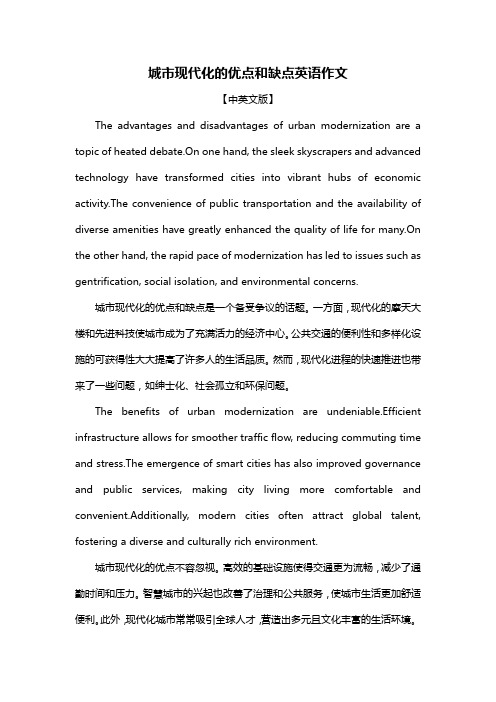
城市现代化的优点和缺点英语作文【中英文版】The advantages and disadvantages of urban modernization are a topic of heated debate.On one hand, the sleek skyscrapers and advanced technology have transformed cities into vibrant hubs of economic activity.The convenience of public transportation and the availability of diverse amenities have greatly enhanced the quality of life for many.On the other hand, the rapid pace of modernization has led to issues such as gentrification, social isolation, and environmental concerns.城市现代化的优点和缺点是一个备受争议的话题。
一方面,现代化的摩天大楼和先进科技使城市成为了充满活力的经济中心。
公共交通的便利性和多样化设施的可获得性大大提高了许多人的生活品质。
然而,现代化进程的快速推进也带来了一些问题,如绅士化、社会孤立和环保问题。
The benefits of urban modernization are undeniable.Efficient infrastructure allows for smoother traffic flow, reducing commuting time and stress.The emergence of smart cities has also improved governance and public services, making city living more comfortable and convenient.Additionally, modern cities often attract global talent, fostering a diverse and culturally rich environment.城市现代化的优点不容忽视。
城市化的优势和缺点英语作文
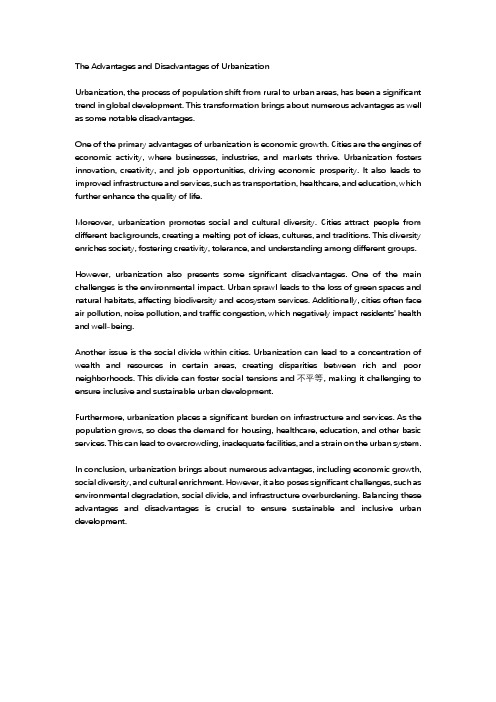
The Advantages and Disadvantages of UrbanizationUrbanization, the process of population shift from rural to urban areas, has been a significant trend in global development. This transformation brings about numerous advantages as well as some notable disadvantages.One of the primary advantages of urbanization is economic growth. Cities are the engines of economic activity, where businesses, industries, and markets thrive. Urbanization fosters innovation, creativity, and job opportunities, driving economic prosperity. It also leads to improved infrastructure and services, such as transportation, healthcare, and education, which further enhance the quality of life.Moreover, urbanization promotes social and cultural diversity. Cities attract people from different backgrounds, creating a melting pot of ideas, cultures, and traditions. This diversity enriches society, fostering creativity, tolerance, and understanding among different groups.However, urbanization also presents some significant disadvantages. One of the main challenges is the environmental impact. Urban sprawl leads to the loss of green spaces and natural habitats, affecting biodiversity and ecosystem services. Additionally, cities often face air pollution, noise pollution, and traffic congestion, which negatively impact residents' health and well-being.Another issue is the social divide within cities. Urbanization can lead to a concentration of wealth and resources in certain areas, creating disparities between rich and poor neighborhoods. This divide can foster social tensions and不平等, making it challenging to ensure inclusive and sustainable urban development.Furthermore, urbanization places a significant burden on infrastructure and services. As the population grows, so does the demand for housing, healthcare, education, and other basic services. This can lead to overcrowding, inadequate facilities, and a strain on the urban system.In conclusion, urbanization brings about numerous advantages, including economic growth, social diversity, and cultural enrichment. However, it also poses significant challenges, such as environmental degradation, social divide, and infrastructure overburdening. Balancing these advantages and disadvantages is crucial to ensure sustainable and inclusive urban development.。
写一篇关于城市化的利与弊的英文作文
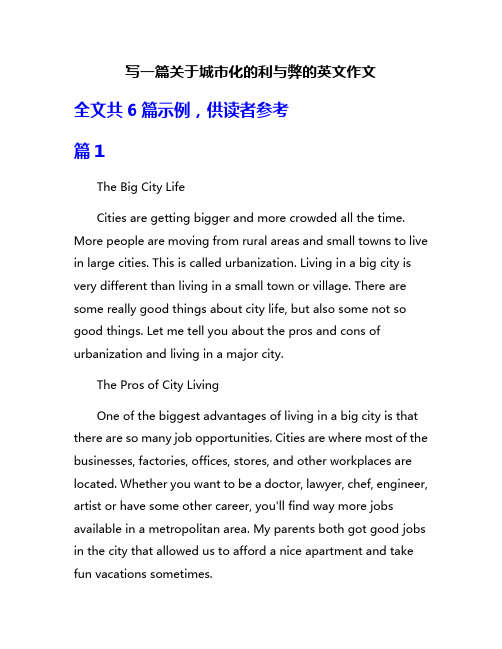
写一篇关于城市化的利与弊的英文作文全文共6篇示例,供读者参考篇1The Big City LifeCities are getting bigger and more crowded all the time. More people are moving from rural areas and small towns to live in large cities. This is called urbanization. Living in a big city is very different than living in a small town or village. There are some really good things about city life, but also some not so good things. Let me tell you about the pros and cons of urbanization and living in a major city.The Pros of City LivingOne of the biggest advantages of living in a big city is that there are so many job opportunities. Cities are where most of the businesses, factories, offices, stores, and other workplaces are located. Whether you want to be a doctor, lawyer, chef, engineer, artist or have some other career, you'll find way more jobs available in a metropolitan area. My parents both got good jobs in the city that allowed us to afford a nice apartment and take fun vacations sometimes.Another great thing about cities is there's always something to do for entertainment and cultural activities. You've got museums, concerts, theater shows, sporting events, and restaurants from every type of cuisine you can imagine. The city never sleeps with all the nightlife – there are bars, nightclubs, comedy shows, and live music venues open late. Smaller towns are quieter with not as many things going on. In a city, you'll never be bored!Cities also tend to have really good public transportation systems to help people get around without a car. There are bus routes, subways, trains, taxis, and ride shares available. Not having to drive and park everywhere makes living in the city very convenient, especially for kids too young to drive. We just hop on the bus or subway to get where we need to go.The diversity in cities is another big perk. You'll meet people from all different backgrounds, cultures, religions, and walks of life. With so many diverse residents, there are lots of ethnic neighborhoods to explore and experience different cultures through their food, festivals, and traditions. My best friends are from all over the world – India, Mexico, Somalia, and Korea.We've learned so much about each other's customs and cuisines. It's amazing!The Cons of Urban LivingWhile cities offer many advantages, there are also some major downsides to being a city dweller that you have to consider. One of the biggest issues is overcrowding and population density. Cities are packed with people living on top of each other in apartment complexes and crowds everywhere you go. It can feel chaotic, loud, and overwhelming at times with so much traffic, noise from construction, commotion on the streets, and just masses of people around constantly.Along with overcrowding comes higher costs for housing and just about everything else. Real estate is extremely expensive in cities, so you'll pay top dollar to rent or buy property even for a small living space. Things like groceries, utilities, transportation, and entertainment also tend to cost more in urban areas. For our family of four, we pay almost double the rent that my relatives in a small town pay for their whole house!Another negative aspect of city life is the increased crime rates and safety concerns, especially for kids. With more people crammed together, there are more opportunities for theft, assault, drugs, and other criminal activity in cities compared to suburban areas. My parents are very strict about where I can goby myself because of the dangers that exist. We always have to be alert and take precautions.Cities also tend to have much more pollution than rural places. With exhaust from so many cars and factories, the air quality in urban centers is often quite poor. There's smog, dust, litter, and garbage piled up in some areas as well. My friends who grew up in the country say their hometowns are much cleaner with fresh air. Cities can be kind of dirty environments.The Balanced ViewSo as you can see, there are significant pros and cons to urbanization and living in a major city. It offers incredible opportunities, amenities, and diversity. But it also comes with downsides like overcrowding, high expenses, safety issues, and pollution. Every family has to decide what environment and lifestyle suits them best.My parents say that while city life is challenging in many ways, they feel the benefits outweigh the negatives for our family situation right now. They appreciate having good career options andexposing me to people from all different backgrounds. They want me to take advantage of all the enriching activities available in an urban setting.However, my parents don't rule out possibly moving to a quieter suburb or semi-rural area one day when I'm older if city living becomes too hectic or expensive. A lot depends on future job situations and what our priorities are at that stage in our lives. Many people choose to leave cities as empty nesters or retirees.For now though, our city apartment is my home and where I'm happily growing up experiencing the energy, opportunities, and excitement that urban living offers. Just don't be surprised if you visit me sometime and I've relocated to a calmer, wide open small town somewhere! The rural life does have its advantages too.篇2The Pros and Cons of City LifeHave you ever wondered what it's like to live in a big city? Well, let me tell you all about it! Cities are amazing places with lots of people, tall buildings, and so many fun things to do. But they can also be crowded, noisy, and a bit messy sometimes. Let's explore the good and the bad sides of city life.The Pros of Living in a CityLots of OpportunitiesIn a city, there are so many job opportunities for people. You can find work in offices, restaurants, stores, hospitals, schools, and many other places. There are also lots of schools and colleges, so you can get a good education and learn new skills.Entertainment GaloreCities never get boring! There are always exciting things happening, like concerts, plays, festivals, and sports events. You can go to the movies, visit museums, or just hang out at the park. There are also lots of restaurants where you can try different kinds of delicious food from all over the world.Easy TransportationIn cities, you don't really need a car to get around. You can take the bus, train, or subway to go wherever you want. Some people even ride bicycles or scooters to get to work or school. It's easy to travel without having to worry about traffic jams or finding a parking spot.Diverse CommunitiesCities are home to people from all kinds of backgrounds and cultures. You can learn about different languages, traditions, and ways of life. You can make friends with kids from all over the world and learn so much from them.The Cons of Living in a CityOvercrowding and TrafficOne of the biggest problems in cities is that there are too many people living in a small area. This can lead to overcrowding in schools, hospitals, and public spaces. The roads are always packed with cars, buses, and trucks, which can cause heavy traffic and pollution.Noise and PollutionCities are noisy places, with the sounds of cars honking, construction work, and people shouting. The air can also get polluted from vehicle emissions and factories. This can be harmful to our health and the environment.High Cost of LivingLiving in a city is expensive. The rent or cost of buying a house is usually much higher than in smaller towns or rural areas. Even basic things like groceries, transportation, and utilities can be more costly in cities.Crime and Safety IssuesUnfortunately, cities can sometimes be unsafe places. There is a higher risk of crimes like theft, robbery, and violence in crowded areas. Parents have to be very careful and teach their children how to stay safe when out and about.As you can see, there are both positive and negative aspects to city life. Some people love the excitement and opportunities that cities offer, while others prefer the peace and quiet of smaller towns or the countryside.Personally, I think cities are amazing places, but they can also be overwhelming at times. It's important to find a balance and enjoy the best of both worlds. Maybe we could live in a city during the week for work and school, and then escape to the countryside on weekends for some fresh air and relaxation!What do you think? Would you like to live in a big city when you grow up, or would you prefer a quieter place? Let me know your thoughts!篇3The Ups and Downs of City LivingHave you ever been to a big city like New York or Tokyo? They're huge, with tall buildings, lots of people, and so much going on! Cities are cool places, but they also have somenot-so-cool parts too. Let me tell you about the good things and bad things about living in a city.The Awesome Stuff About CitiesOne of the best things about cities is that there's always something to do! You'll never get bored because there are tons of fun places to go and interesting things to see. In the city, you can visit museums to learn about art, history, and science. There are also theaters where you can watch plays, concerts, and movies. And don't forget about all the cool parks, zoos, and aquariums!Another great thing about cities is the food. You can find restaurants from all over the world serving delicious foodsyou've never tried before. Whether you want pizza, tacos, sushi, or something else entirely, the city has it all. And if you get hungry late at night, there are always places that stay open really late or even 24 hours a day!Cities are also super convenient. You don't need a car because there are buses, trains, and subways to take you wherever you need to go. And if you need to buy something,there are shops and stores all around selling everything you can imagine.The Not-So-Great Parts of City LifeWhile cities are exciting, they can also be really crowded and noisy. Imagine having hundreds of people on the same street or subway car as you – it gets pretty cramped and loud! All the cars, trucks, and construction also make a ton of noise that can be annoying.Another downside of cities is that there's a lot of pollution. With so many vehicles on the roads and factories in the area, the air isn't as clean as it is in smaller towns or the countryside. The pollution can make it hard to breathe and can even make people sick.Cities can also be expensive places to live. Rent for apartments is usually higher than in suburbs or rural areas. And things like food, clothes, and entertainment tend to cost more too. That makes it tough for some families to afford to live in the city.One more negative aspect of urban life is crime. While most neighborhoods are safe, cities tend to have more problems with things like theft, vandalism, and violent crimes than smallertowns do. You have to be extra careful when you're out and about.The Choice is YoursSo those are some of the major pros and cons of living in a big city. Every place has its good points and bad points, and cities are no exception. Personally, I think the excitement and opportunities of the city make it a super cool place, even with the downsides like noise and crowds. But maybe you'd prefer the peace and quiet of a small town instead. No matter where you live, there will be trade-offs – it's up to you to decide what's most important!Whether you're a city kid or a small-town kid, I hope you have a great community filled with fun activities, friendly people, and plenty of adventures. The world is an amazing place with so much to explore, no matter if you're in the heart of a huge metropolis or a tiny little village. The choice is yours!篇4The Big City LifeHave you ever wondered what it would be like to live in a huge city? Cities are getting bigger and bigger all the time asmore people move from small towns and the countryside into urban areas. This is called urbanization. While living in a major city definitely has some cool advantages, there are also some not-so-great downsides that come with the big city life. Let me break it down for you!The Pros of City LivingOne of the biggest perks of residing in a metropolitan area is that there is just SO much to do! In a small town, you might get bored after a while because there are limited options for entertainment, restaurants, shopping, and activities. But a gigantic city? Forget about it! There are endless opportunities to try new cuisines from around the world, watch live music and theater shows, visit world-class museums, go shopping at massive malls, and more. You'll never run out of fresh and exciting experiences.Another great thing about cities is that there are way more job and career opportunities compared to rural areas. Larger cities are home to the headquarters of major companies, hospitals, universities, and other important organizations and businesses. This means more jobs across all kinds of fields and industries. It's much easier to find a job you're passionate about in a bustling urban center.Cities also make it very convenient to get around and travel without needing a car. Most major metros have excellent public transportation systems with buses, trains, and subways that can zip you across town. Lots of people also use ride-sharing services, bike-sharing programs, or just walk to their destinations since amenities are clustered closer together. This cuts down on traffic and air pollution.The Cons of Urban LifeWhile cities offer an abundance of job options, the reality is that the cost of living tends to be much higher in urban areas. Housing, groceries, transportation, and entertainment are all more expensive. Many families struggle to keep up with soaring rental prices or mortgage costs. The job opportunities have to be weighed against the economic challenges.Another big drawback is the issue of overcrowding. Cities are densely populated with huge numbers of people crammed into a relatively small geographic area. This overcrowding can make cities feel chaotic, loud, dirty and stressful at times. Things like traffic jams, long lines, litterand excessive noise can take a toll. In very populated cities, personal space and privacy are often luxuries.Cities also tend to have higher crime rates than suburban and rural areas. With so many people compressed together, it creates more opportunities for crimes like theft, assault, and vandalism to occur. Parents often worry about the safety risks of raising children in cities and having them travel across urban areas alone.The Urbanization TrendLike it or not, the worldwide trend is toward urbanization as the global population continues growing rapidly. It's estimated that over 60% of people will be living in urban areas by the year 2050! For kids my age, chances are very high that we will end up residing in a major city at some point in our lives.While cities absolutely have their downsides with higher costs, overcrowding, crime and other problems, they also provide unmatched cultural diversity, job options, and amenities.I think the key is that city planning and infrastructure needs to keep pace with urbanization. If cities can be developed with adequate affordable housing, efficient public services, green spaces, and thoughtful regulation, then the advantages of urban living could easily outweigh the disadvantages for most people.But those are just my thoughts! What do you think about the big city life? Would you like growing up in a major metropolitanarea or does a quieter small town appeal to you more? Maybe a medium-sized city could offer a nice balance of amenities without as much overcrowding and cost? I'd love to hear your perspective!篇5The Bright Lights and Tall Buildings: The Good and Bad of City LifeHave you ever walked through a big city and felt amazed by the towering skyscrapers and the bustling streets? Cities are incredible places, filled with excitement, opportunities, and fascinating people from all over the world. But as awesome as cities can be, they also have their downsides. Let me tell you about the good and the not-so-good sides of living in a city.The Awesome Parts of City LifeOne of the best things about cities is that there's always something to do! You'll never get bored because cities arejam-packed with fun activities. There are museums to explore, parks to play in, theaters to watch shows, and restaurants serving delicious food from every culture you can imagine. In my city, we have a huge science museum with interactive exhibits that make learning about space and dinosaurs super fun!Cities also have excellent schools and universities, which means kids like me can get a great education. My school has a state-of-the-art computer lab, a huge library, and teachers who are experts in their subjects. When I grow up, I'll have the opportunity to attend a top university right in the heart of the city.Another awesome thing about cities is the diversity. People from all over the world come to live and work in cities, which means you get to experience different cultures, languages, and traditions. In my neighborhood alone, I have friends whose families are from China, Mexico, India, and Nigeria. We love learning about each other's customs and trying different foods from around the globe.The Not-So-Awesome Parts of City LifeWhile cities offer many advantages, they also have some pretty big downsides. One of the biggest problems is pollution. With so many cars, factories, and people packed into a small area, the air in cities can get really dirty and smoggy. This makes it harder to breathe and can cause health issues like asthma and lung problems.Noise pollution is also a major issue in cities. The constant honking of horns, construction work, and loud music can beoverwhelming and make it hard to concentrate or get a good night's sleep. Sometimes, I wish I could escape to a quieter place in the countryside.Another downside of city living is the lack of green spaces and nature. While cities usually have parks, they're often small and crowded. It's not the same as being able to roam freely in wide-open spaces and forests. I miss being able to go on long hikes and see wildlife like deer, rabbits, and birds in their natural habitats.Traffic and overcrowding are also major headaches in cities. The streets are always jammed with cars, buses, and people, which can make getting around a nightmare. Sometimes, it takes my family over an hour just to drive a few miles because of gridlock traffic. And don't even get me started on how crowded the subways and buses get during rush hour!The Cost of City LivingOne of the biggest drawbacks of living in a city is how expensive it can be. Housing costs are usually astronomical, with even small apartments costing a fortune. My parents have to work really hard to afford our tiny two-bedroom place in the city. And that's not even counting the high costs of things like food, entertainment, and transportation.Because space is so limited in cities, everything seems to be crammed together. Neighborhoods are densely populated, with high-rise apartments and houses packed tightly side by side. While this means you're never far from shops and amenities, it also means there's very little privacy or personal space.The Pros and Cons: It's a Trade-OffAs you can see, there are both amazing and not-so-amazing aspects to living in a city. On the one hand, cities offer incredible opportunities for education, culture, and entertainment. They're vibrant, diverse places where you'll never run out of things to do or people to meet.On the other hand, city living can be stressful, expensive, and overwhelming. The pollution, noise, traffic, and lack of nature can take a toll on your health and wellbeing. It's a trade-off between convenience and excitement versus peace, quiet, and affordability.Personally, I love the energy and diversity of my city, but sometimes I dream of living in a smaller town or the countryside where I can breathe fresh air and enjoy wide-open spaces. Maybe when I'm older, I'll split my time between the city and a quiet cabin in the woods – that way, I can have the best of both worlds!For now, I'll continue to appreciate the amazing opportunities and experiences that come with living in a bustling metropolis. But I'll also make sure to take breaks from the hustle and bustle by visiting parks, going on nature hikes, or just spending quiet time at home. It's all about finding the right balance and making the most of both the urban and natural worlds around us.篇6The Growth of Cities: Good or Bad?Have you ever been to a big city like New York or Tokyo? Cities are places with lots of tall buildings, busy streets, and millions of people living and working all crammed together. More and more people around the world are moving from small towns and villages into these huge urban areas. This trend is called urbanization.Urbanization means the process where cities get bigger as more people move into them from rural countryside areas. It's been happening for a long time, but it's picked up speed in recent decades. Back in 1800, only 3% of the world's population lived in cities. But today over half of all humans live in urban areas, and that number keeps growing every year.There are some really good things about people moving to cities, but also some significant downsides we have to think carefully about. Let's take a look at the pros and cons of urbanization:Pros of UrbanizationBetter Job Opportunities: Cities are where most of the businesses, factories, offices, and economic activity happens. By moving to a city, people have way more chances to get a good job and earn enough money to support their family. There just aren't as many job options in small rural towns.Access to Services: Cities have way more hospitals, schools, grocery stores, restaurants, parks, libraries, and other amenities compared to small towns. People living in cities can generally get medical care, education, food, and entertainment much more easily.Efficient Use of Resources: It's more efficient to provide things like electricity, heat, clean water, internet, public transportation and garbage collection to densely populated cities rather than spread out rural areas. Cities allow us to use fewer resources per person.Cultural Diversity: Cities attract people from all over the world with diverse backgrounds, cultures, religions, and perspectives. Urban residents get to experience different foods, holidays, art, music, and traditions. Cities are great melting pots!Cons of UrbanizationHousing Shortages: With so many people crammed into a small area, it can be really hard to find affordable housing in cities. A lot of urban dwellers end up living in cramped,run-down apartments or even slums without good sanitation.Traffic Congestion: Cities can get incredibly crowded with cars, buses, delivery trucks, and so much vehicle traffic. All that congestion causes air pollution, long delays for commuters, and injuries from vehicle crashes.Increased Crime: Unfortunately, crime rates like theft, assault, and drug use tend to be higher in densely populated cities compared to rural areas, especially in poorer neighborhoods without good policing.Loss of Land: To build more housing, roads, stores, and factories in cities, we have to tear down a lot of green spaces like forests, parks, and farmland. This destroys natural animal habitats and Earth's precious plant life.Those are some of the key pros and cons of the urbanization trend. As you can see, it's a complex issue with both positive and negative impacts. Whether urbanization is overall good or bad depends on how well cities are planned and maintained.Well-designed cities with good public transportation, ample housing, parks, and community services can provide lots of great opportunities for people while minimizing issues like pollution and crime. But poorly planned cities that grow too fast can become overcrowded concrete jungles plagued by many problems.What do you think about the growth of cities? Would you prefer living in a huge urban area like Shanghai or a quiet small town? There are arguments on both sides of this debate over urbanization. Humans will need to make wise choices to get the most benefits while limiting the downsides as more people move to cities in the coming years.。
城市化的利弊英语作文
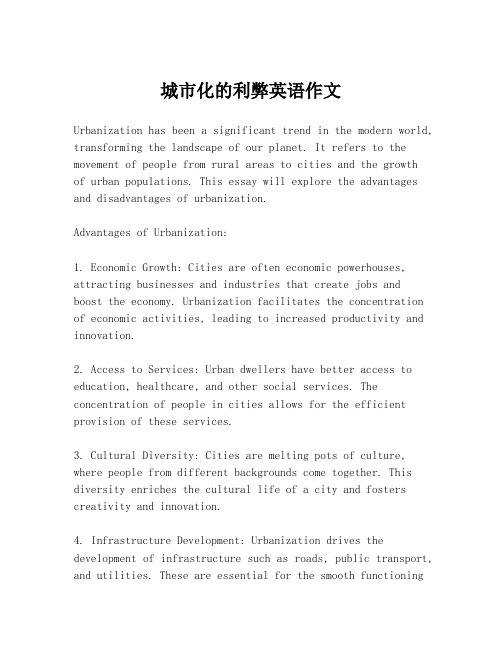
城市化的利弊英语作文Urbanization has been a significant trend in the modern world, transforming the landscape of our planet. It refers to the movement of people from rural areas to cities and the growthof urban populations. This essay will explore the advantages and disadvantages of urbanization.Advantages of Urbanization:1. Economic Growth: Cities are often economic powerhouses, attracting businesses and industries that create jobs andboost the economy. Urbanization facilitates the concentration of economic activities, leading to increased productivity and innovation.2. Access to Services: Urban dwellers have better access to education, healthcare, and other social services. The concentration of people in cities allows for the efficient provision of these services.3. Cultural Diversity: Cities are melting pots of culture, where people from different backgrounds come together. This diversity enriches the cultural life of a city and fosters creativity and innovation.4. Infrastructure Development: Urbanization drives the development of infrastructure such as roads, public transport, and utilities. These are essential for the smooth functioningof a city and improve the quality of life for its residents.Disadvantages of Urbanization:1. Overcrowding: One of the most significant issues with urbanization is overcrowding. As more people move to cities, there is increased pressure on housing, leading to high rents and property prices.2. Environmental Impact: The growth of cities can lead to environmental degradation. Increased pollution, traffic congestion, and the loss of green spaces are common problems associated with urbanization.3. Social Inequality: While cities offer opportunities, they also harbor social inequalities. The gap between the rich and the poor can widen, leading to issues such as poverty and homelessness.4. Strain on Resources: The rapid growth of urban populations puts a strain on resources such as water, electricity, and food. This can lead to shortages and increased costs for essential commodities.In conclusion, urbanization is a complex phenomenon with both positive and negative implications. While it can drive economic growth and improve access to services, it also brings challenges such as overcrowding and environmental degradation. It is crucial for policymakers to address these issues to ensure sustainable urban development that benefits all residents.。
城市化可能带来的优点与缺点英语作文
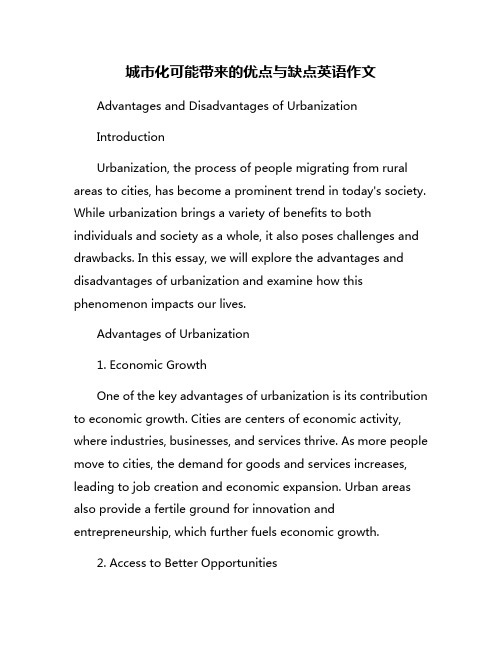
城市化可能带来的优点与缺点英语作文Advantages and Disadvantages of UrbanizationIntroductionUrbanization, the process of people migrating from rural areas to cities, has become a prominent trend in today's society. While urbanization brings a variety of benefits to both individuals and society as a whole, it also poses challenges and drawbacks. In this essay, we will explore the advantages and disadvantages of urbanization and examine how this phenomenon impacts our lives.Advantages of Urbanization1. Economic GrowthOne of the key advantages of urbanization is its contribution to economic growth. Cities are centers of economic activity, where industries, businesses, and services thrive. As more people move to cities, the demand for goods and services increases, leading to job creation and economic expansion. Urban areas also provide a fertile ground for innovation and entrepreneurship, which further fuels economic growth.2. Access to Better OpportunitiesUrbanization offers individuals access to better job opportunities, education, healthcare, and social services. Cities are hubs of diverse industries and institutions, providing a wide range of career options for individuals seeking employment. Moreover, urban areas often have better schools, hospitals, and recreational facilities, offering residents a higher quality of life.3. Infrastructure DevelopmentCities are characterized by well-developed infrastructure, including roads, public transportation, utilities, and communication networks. Urbanization drives investment in infrastructure development, leading to improved connectivity, efficiency, and convenience for residents. Access to modern amenities enhances the overall living standards of urban dwellers and improves their quality of life.4. Cultural DiversityUrbanization fosters cultural diversity by bringing together people from different backgrounds, beliefs, and traditions. Cities are melting pots of diverse cultures, languages, and cuisines, creating a vibrant and dynamic social environment. Exposure to different cultures broadens people's perspectives, promotes tolerance and understanding, and enriches the cultural fabric of society.Disadvantages of Urbanization1. Overcrowding and PollutionUrbanization often results in overcrowding, as cities struggle to accommodate the influx of people. Overcrowded cities face challenges such as housing shortages, traffic congestion, and insufficient public services. Additionally, urbanization contributes to environmental pollution, including air pollution, water contamination, and waste accumulation, degrading the quality of life and endangering public health.2. Income InequalityUrbanization exacerbates income inequality, as cities become divided between affluent and marginalized populations. Wealthier residents tend to cluster in exclusive neighborhoods with access to premium amenities, while low-income individuals are confined to overcrowded slums with inadequate living conditions. Income inequality in urban areas leads to social tensions, crime rates, and disparities in health and education.3. Strain on ResourcesUrbanization places a strain on resources such as water, energy, and land, as cities consume vast quantities of resources to sustain their population and infrastructure. Rapid urbanizationdepletes natural resources, exacerbates environmental degradation, and accelerates climate change. Additionally, the demand for resources in cities often exceeds supply, leading to shortages, price hikes, and competition among residents.4. Social IsolationUrbanization can contribute to social isolation and alienation among city residents, as the fast-paced urban lifestyle leaves little time for social interactions and community engagement. The anonymity of urban living can lead to feelings of loneliness, disconnectedness, and lack of social support. Moreover, the transient nature of urban populations, with people constantly moving in and out of cities, hinders the development of strong social ties and cohesive communities.ConclusionIn conclusion, urbanization presents a complex mix of advantages and disadvantages that shape our urban landscapes and influence our daily lives. While urbanization drives economic growth, provides better opportunities, and fosters cultural diversity, it also leads to overcrowding, pollution, income inequality, resource strain, and social isolation. As we navigate the challenges of urbanization, it is crucial to strike a balance between the benefits and drawbacks of urban living, ensuringsustainable, inclusive, and livable cities for all residents. By addressing the negative impacts of urbanization and harnessing its potential for positive change, we can create vibrant, resilient, and equitable urban environments that enhance the well-being and prosperity of society as a whole.。
中国城市化的好处和坏处英语作文
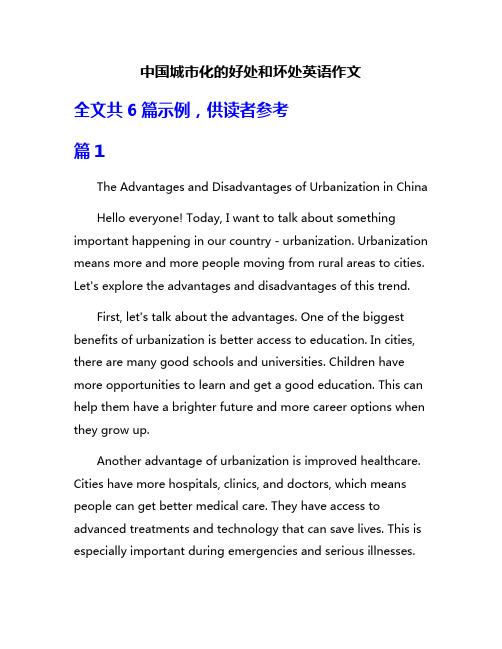
中国城市化的好处和坏处英语作文全文共6篇示例,供读者参考篇1The Advantages and Disadvantages of Urbanization in ChinaHello everyone! Today, I want to talk about something important happening in our country - urbanization. Urbanization means more and more people moving from rural areas to cities. Let's explore the advantages and disadvantages of this trend.First, let's talk about the advantages. One of the biggest benefits of urbanization is better access to education. In cities, there are many good schools and universities. Children have more opportunities to learn and get a good education. This can help them have a brighter future and more career options when they grow up.Another advantage of urbanization is improved healthcare. Cities have more hospitals, clinics, and doctors, which means people can get better medical care. They have access to advanced treatments and technology that can save lives. This is especially important during emergencies and serious illnesses.Moreover, urbanization brings more job opportunities. In cities, there are many companies and businesses that need workers. People can find different kinds of jobs and earn a better income. This can improve their living standards and help them provide a good life for their families.Despite these advantages, there are also some disadvantages of urbanization. One major concern is the high cost of living in cities. Housing, food, and transportation can be more expensive compared to rural areas. This can make it difficult for some families to afford basic necessities and lead to financial stress.Additionally, urbanization can lead to environmental problems. As cities grow, more buildings are constructed, and more vehicles are on the roads. This can cause air and water pollution, as well as congestion and traffic jams. It is important for cities to implement eco-friendly solutions and sustainable development to protect the environment.Furthermore, urbanization can lead to the loss of traditional culture and values. In rural areas, people have strong connections to their land, history, and traditions. But when they move to cities, they may lose touch with their cultural roots. It isnecessary to preserve and promote our traditional culture, even in urban areas.In conclusion, urbanization in China has both advantages and disadvantages. It provides better education, healthcare, and job opportunities, but it also comes with a higher cost of living, environmental challenges, and cultural changes. It is important for the government and citizens to work together to make cities more livable, sustainable, and inclusive for everyone.Remember, no matter where we live - in cities or in rural areas - we should always cherish our communities, take care of the environment, and keep learning and growing.篇2The Advantages and Disadvantages of Urbanization in ChinaHello friends! Today, I want to talk about something very important that is happening in our country - urbanization. Urbanization means the growth of cities and the movement of people from rural areas to urban areas. China has experienced rapid urbanization in recent years, and it has both advantages and disadvantages. Let's explore them together!First, let's talk about the advantages of urbanization. One of the biggest benefits is that cities provide more job opportunities. When people move from rural areas to cities, they can find better-paying jobs and improve their living standards. This means they can earn more money to support their families and have a better quality of life.Another advantage of urbanization is better access to education and healthcare. Cities have more schools and hospitals, which means children can get a good education and people can receive better medical care. This can lead to a healthier and more educated population, which is important for the development of our country.Urbanization also brings improved infrastructure. Cities have modern transportation systems like subways, buses, and highways, making it easier for people to travel around. Moreover, cities have better facilities like shopping malls, parks, and entertainment venues, providing people with more recreational options.However, we must also consider the disadvantages of urbanization. One major problem is overpopulation. As more people move to cities, the population becomes concentrated in urban areas, leading to overcrowding. This can put a strain onresources such as housing, water, and electricity. It is important for the government to plan and manage urbanization properly to avoid these issues.Another disadvantage is pollution. Cities produce a lot of pollution from factories, vehicles, and waste. This can harm the environment and affect people's health. It is crucial for us to find ways to reduce pollution and protect our environment. We can encourage the use of clean energy, promote recycling, and plant more trees in cities to improve air quality.In addition, urbanization can lead to the loss of traditional culture and the disappearance of farmland. As cities expand, they may encroach on rural areas, resulting in the loss of agricultural land. It is important to preserve our cultural heritage and find a balance between development and conservation.In conclusion, urbanization in China has both advantages and disadvantages. It brings job opportunities, better education and healthcare, and improved infrastructure. However, it also causes overpopulation, pollution, and the loss of traditional culture. As young citizens, we should be aware of these issues and work together to create a sustainable and harmonious urban environment for future generations.Remember, it is important to build cities that are not only modern and developed but also environmentally friendly and culturally rich. Let's strive for a better future for our country!I hope you found this essay helpful and informative. Good luck with your studies!篇3当然可以!以下是一篇关于中国城市化的好处和坏处的英语作文,使用小学生的语言风格。
城市化的优缺点和自己的观点英语作文
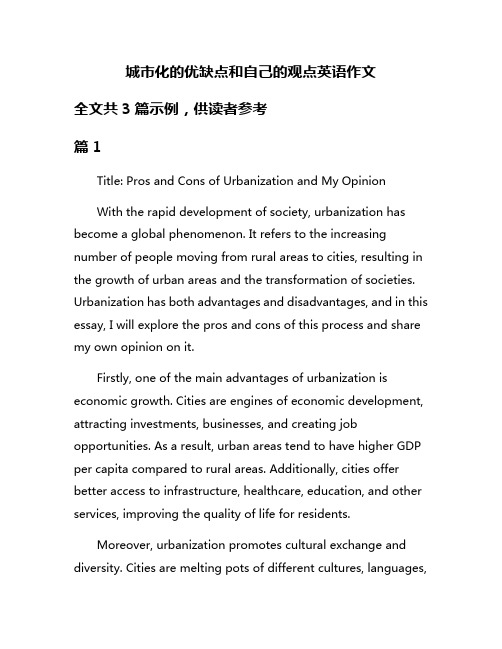
城市化的优缺点和自己的观点英语作文全文共3篇示例,供读者参考篇1Title: Pros and Cons of Urbanization and My OpinionWith the rapid development of society, urbanization has become a global phenomenon. It refers to the increasing number of people moving from rural areas to cities, resulting in the growth of urban areas and the transformation of societies. Urbanization has both advantages and disadvantages, and in this essay, I will explore the pros and cons of this process and share my own opinion on it.Firstly, one of the main advantages of urbanization is economic growth. Cities are engines of economic development, attracting investments, businesses, and creating job opportunities. As a result, urban areas tend to have higher GDP per capita compared to rural areas. Additionally, cities offer better access to infrastructure, healthcare, education, and other services, improving the quality of life for residents.Moreover, urbanization promotes cultural exchange and diversity. Cities are melting pots of different cultures, languages,and traditions, creating a dynamic and vibrant environment. People from diverse backgrounds come together, interact, and learn from each other, fostering tolerance and understanding.On the other hand, urbanization also brings about several disadvantages. One of the major drawbacks is environmental degradation. The rapid expansion of cities leads to deforestation, pollution, and the depletion of natural resources. Urban areas often suffer from air and water pollution, traffic congestion, and waste management issues, impacting the health and well-being of residents.Furthermore, urbanization can lead to social problems such as income inequality, crime rates, and overcrowding. As cities grow, the gap between the rich and the poor widens, creating social tensions and disparities. Moreover, the concentration of a large population in urban areas can strain public services and infrastructure, leading to overcrowding and inadequate housing conditions.In conclusion, urbanization has its pros and cons. While it contributes to economic growth, cultural exchange, and improved quality of life, it also poses challenges in terms of environmental sustainability, social equity, and public health. In my opinion, I believe that urbanization can be a beneficialprocess if managed effectively. Governments and urban planners should prioritize sustainable development, promote green technologies, invest in public transportation, and address social inequalities to ensure that urbanization benefits all members of society.By striking a balance between economic growth and environmental conservation, urbanization can create livable, inclusive, and resilient cities for present and future generations.篇2Title: Advantages and Disadvantages of Urbanization and My OpinionUrbanization is the process of population shifting from rural areas to urban areas, leading to the growth of cities and towns. This phenomenon has both positive and negative impacts on society and the environment. In this essay, we will discuss the advantages and disadvantages of urbanization and present my opinion on this controversial topic.Advantages of Urbanization:1. Economic Growth: Urbanization promotes economic development by creating job opportunities, attracting investments, and stimulating consumer demand. Cities serve ashubs for various industries, businesses, and services, contributing to the overall economic growth of a country.2. Infrastructure Development: Urban areas are equipped with better infrastructure facilities such as roads, railways, airports, and communication networks, which enhance transportation, communication, and connectivity. This leads to improved accessibility, efficiency, and convenience for residents and businesses.3. Social Opportunities: Cities offer a wide range of social, cultural, educational, and recreational opportunities. Urban residents have access to quality healthcare, education, entertainment, and social activities, leading to a higher standard of living and overall well-being.4. Innovation and Creativity: Urbanization fosters innovation, creativity, and knowledge exchange by bringing together diverse populations, ideas, and resources. Cities serve as centers of innovation, research, technology, and entrepreneurship, driving progress and development in various fields.Disadvantages of Urbanization:1. Overpopulation: Rapid urbanization can lead to overpopulation, overcrowding, and congestion in cities, resultingin increased pressure on resources, infrastructure, and public services. This can lead to social problems, inequality, and quality of life issues for residents.2. Environmental Degradation: Urbanization contributes to environmental degradation through pollution, deforestation, habitat loss, and resource depletion. Cities generate large amounts of waste, emissions, and pollution, leading to air, water, and soil contamination, and biodiversity loss.3. Urban Sprawl: Unplanned urbanization can lead to urban sprawl, the expansion of cities into surrounding rural areas, resulting in land degradation, habitat fragmentation, and loss of agricultural land. This can disrupt natural ecosystems, wildlife habitats, and biodiversity.4. Social Inequality: Urbanization can exacerbate social inequality, poverty, and social exclusion, as cities may concentrate wealth, resources, and opportunities in certain areas while neglecting others. This can lead to social tensions, crime, and marginalization of disadvantaged groups.My Opinion:In my opinion, urbanization is a double-edged sword with both advantages and disadvantages. While urbanization offerseconomic, social, and cultural benefits, it also poses challenges such as overpopulation, environmental degradation, and social inequality. To harness the benefits of urbanization while mitigating its negative impacts, sustainable urban planning, infrastructure development, and policy interventions are crucial. It is essential to promote compact, inclusive, and environmentally friendly cities that prioritize the well-being of residents, protect natural resources, and preserve biodiversity. By adopting sustainable urban practices and fostering equitable development, we can create livable, resilient, and prosperous cities for present and future generations.In conclusion, urbanization has the potential to drive economic growth, social progress, and innovation, but it also poses risks and challenges that must be addressed. By striking a balance between urban development and environmental conservation, we can create sustainable, inclusive, and thriving cities that benefit all residents and the planet. Urbanization should be guided by principles of sustainability, equity, and resilience to ensure a better future for urban populations and the environment.篇3With the rapid development of urbanization, more and more people are moving from rural areas to cities in search of better opportunities. Urbanization has both advantages and disadvantages, and in this essay, I will discuss the pros and cons of urbanization as well as my personal viewpoint on this issue.Firstly, let's talk about the advantages of urbanization. One of the main benefits of urbanization is economic growth. Cities serve as hubs for commerce, industry, and innovation, creating job opportunities and increasing the standard of living for residents. Urban areas also offer better access to services such as healthcare, education, transportation, and entertainment. Additionally, cities promote cultural exchange and diversity, fostering creativity and tolerance among the population.On the other hand, urbanization also has its drawbacks. One of the major disadvantages is overcrowding and congestion in cities, leading to pollution, traffic jams, and a high cost of living. Rapid urbanization can also put a strain on infrastructure and public services, resulting in inadequate housing, sanitation, and healthcare facilities. Furthermore, urbanization can lead to social problems such as crime, inequality, and social isolation, as people become disconnected from their communities andstruggle to find a sense of belonging in a fast-paced environment.In my opinion, urbanization is a double-edged sword that brings both benefits and challenges. While urban areas offer greater opportunities for economic advancement and personal growth, they also pose risks to the environment, public health, and social cohesion. It is essential for policymakers to address these issues and implement sustainable urban planning strategies that prioritize the well-being of residents and the environment.In conclusion, urbanization has its advantages and disadvantages, and it is crucial for society to strike a balance between economic development and social welfare. By promoting sustainable urbanization practices and investing in infrastructure, education, and social services, we can create thriving cities that offer a high quality of life for all residents. Urbanization is a complex and multifaceted phenomenon that requires careful consideration and planning to ensure a prosperous and harmonious future for generations to come.。
城市化好处与坏处的简单的英语作文
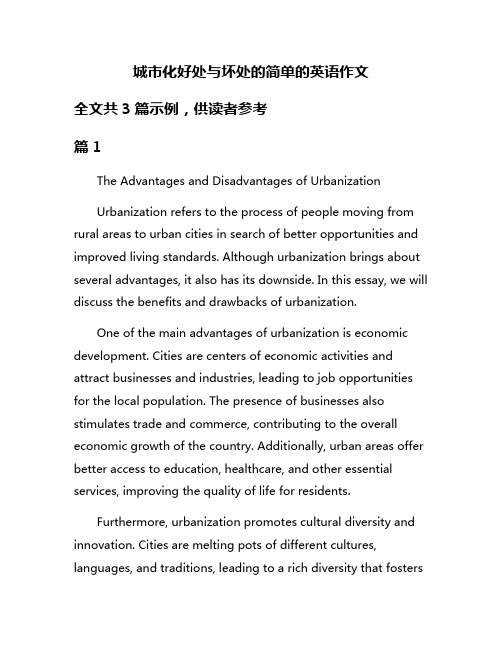
城市化好处与坏处的简单的英语作文全文共3篇示例,供读者参考篇1The Advantages and Disadvantages of UrbanizationUrbanization refers to the process of people moving from rural areas to urban cities in search of better opportunities and improved living standards. Although urbanization brings about several advantages, it also has its downside. In this essay, we will discuss the benefits and drawbacks of urbanization.One of the main advantages of urbanization is economic development. Cities are centers of economic activities and attract businesses and industries, leading to job opportunities for the local population. The presence of businesses also stimulates trade and commerce, contributing to the overall economic growth of the country. Additionally, urban areas offer better access to education, healthcare, and other essential services, improving the quality of life for residents.Furthermore, urbanization promotes cultural diversity and innovation. Cities are melting pots of different cultures, languages, and traditions, leading to a rich diversity that fosterscreativity and new ideas. This diversity also promotes tolerance and understanding among people from different backgrounds, creating a more inclusive society.On the other hand, urbanization also has its drawbacks. One of the main disadvantages is overpopulation and congestion. As more people move to cities, the population density increases, leading to overcrowding and lack of space. This can result in traffic congestion, air pollution, and increased stress on public infrastructure such as transportation, water supply, and waste management.Moreover, urbanization can also lead to social issues such as poverty, crime, and inequality. As more people migrate to cities in search of better opportunities, there is a risk of creating a divide between the rich and the poor. This can result in social unrest and instability, leading to an increase in crime rates and other social problems.In conclusion, urbanization has both advantages and disadvantages. While it promotes economic development, cultural diversity, and innovation, it also leads to overpopulation, congestion, and social issues. It is important for policymakers to address these challenges and ensure sustainable urbandevelopment that benefits all residents. Only then can urbanization be truly beneficial for society as a whole.篇2The Advantages and Disadvantages of UrbanizationUrbanization, refers to the process of increasing the population and societal complexity of cities. It is a double-edged sword that brings both benefits and drawbacks to society. In this essay, we will explore the advantages and disadvantages of urbanization.First and foremost, urbanization leads to economic growth. Cities are hubs for commerce, industry, and innovation. They attract businesses, investments, and skilled labor, which stimulate economic development. Urban areas contribute significantly to the national GDP and provide employment opportunities for millions of people.Furthermore, urbanization brings about improved infrastructure and services. Cities have better transportation systems, healthcare facilities, and educational institutions compared to rural areas. The availability of essential services enhances the quality of life for urban residents and promotes overall well-being.In addition, urbanization facilitates cultural exchange and diversity. Cities are melting pots of different cultures, religions, and traditions. People from diverse backgrounds coexist and interact, fostering mutual understanding and tolerance. This cultural exchange enriches society and promotes social cohesion.On the other hand, urbanization also has its downsides. One of the major drawbacks is urban sprawl and environmental degradation. As cities expand, they encroach upon natural habitats and farmland, leading to deforestation, pollution, and loss of biodiversity. These environmental issues pose serious challenges to sustainability and public health.Moreover, urbanization exacerbates social inequalities and poverty. While cities offer opportunities for economic advancement, they also concentrate wealth and resources in the hands of a few. This creates disparities in income, education, and healthcare access, widening the gap between the rich and poor. Marginalized groups often face discrimination and exclusion in urban areas.Furthermore, urbanization strains public resources and infrastructure. Cities struggle to cope with the rapid influx of migrants, resulting in overcrowded housing, inadequatesanitation, and insufficient public services. This overburdened infrastructure leads to congestion, traffic jams, and social unrest, affecting the overall livability of urban areas.In conclusion, urbanization is a complex phenomenon with both advantages and disadvantages. While it drives economic growth, improves infrastructure, and fosters cultural diversity, it also contributes to environmental degradation, social inequalities, and resource depletion. To harness the benefits of urbanization and mitigate its negative impacts, policymakers, urban planners, and communities need to adopt sustainable and inclusive development strategies. Only by addressing these challenges can we build cities that are vibrant, inclusive, and resilient for future generations.篇3Title: The Pros and Cons of UrbanizationUrbanization refers to the process of population migration from rural areas to urban areas. The increasing rate of urbanization has both positive and negative impacts on society and the environment. In this essay, we will discuss the benefits and drawbacks of urbanization.Firstly, urbanization brings about economic growth. Cities are hubs of economic activities where industries, businesses, and services are concentrated. This leads to job creation and income generation for the urban population. As more people migrate to cities in search of better opportunities, it fuels economic development and helps in reducing poverty levels.Secondly, urbanization enhances access to healthcare and education. Cities usually have better healthcare facilities and educational institutions compared to rural areas. This enables individuals to access quality healthcare services and educational opportunities, thereby improving their overall well-being and standard of living.Furthermore, urbanization promotes cultural diversity and social integration. Cities are melting pots of different cultures, traditions, and beliefs. This cultural exchange fosters tolerance, understanding, and social harmony among people from diverse backgrounds. In addition, urban areas offer a wide range of recreational and entertainment options, contributing to a vibrant and dynamic lifestyle.On the other hand, urbanization also has its downsides. One of the major drawbacks of urbanization is environmental degradation. The rapid expansion of cities results in thedestruction of natural habitats, deforestation, pollution, and resource depletion. This has a detrimental impact on the environment, leading to climate change, loss of biodiversity, and public health risks.Moreover, urbanization exacerbates social inequality and urban poverty. While cities offer opportunities for economic growth, not everyone benefits equally from these opportunities. The urban poor often face social exclusion, inadequate housing, lack of basic services, and limited access to education and healthcare. This widening gap between the rich and the poor creates social tensions and undermines social cohesion.In conclusion, urbanization has both advantages and disadvantages. It is essential to strike a balance between economic growth, environmental sustainability, and social equity to ensure inclusive and sustainable urban development. Government policies and urban planning strategies play a crucial role in managing the challenges of urbanization and harnessing its benefits for the well-being of all citizens.。
城镇化的利与弊英语作文
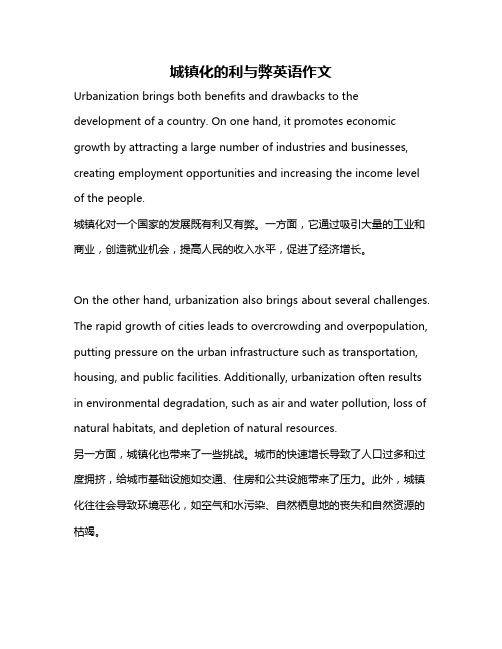
城镇化的利与弊英语作文Urbanization brings both benefits and drawbacks to the development of a country. On one hand, it promotes economic growth by attracting a large number of industries and businesses, creating employment opportunities and increasing the income level of the people.城镇化对一个国家的发展既有利又有弊。
一方面,它通过吸引大量的工业和商业,创造就业机会,提高人民的收入水平,促进了经济增长。
On the other hand, urbanization also brings about several challenges. The rapid growth of cities leads to overcrowding and overpopulation, putting pressure on the urban infrastructure such as transportation, housing, and public facilities. Additionally, urbanization often results in environmental degradation, such as air and water pollution, loss of natural habitats, and depletion of natural resources.另一方面,城镇化也带来了一些挑战。
城市的快速增长导致了人口过多和过度拥挤,给城市基础设施如交通、住房和公共设施带来了压力。
此外,城镇化往往会导致环境恶化,如空气和水污染、自然栖息地的丧失和自然资源的枯竭。
城市化发展利弊作文英文
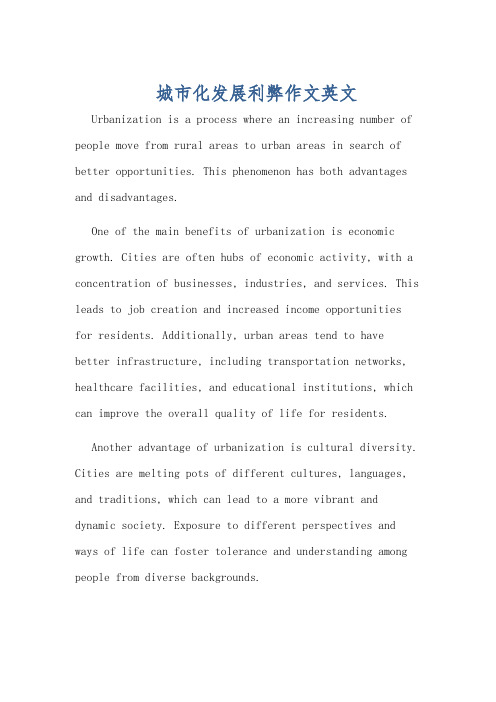
城市化发展利弊作文英文Urbanization is a process where an increasing number of people move from rural areas to urban areas in search of better opportunities. This phenomenon has both advantages and disadvantages.One of the main benefits of urbanization is economic growth. Cities are often hubs of economic activity, with a concentration of businesses, industries, and services. This leads to job creation and increased income opportunitiesfor residents. Additionally, urban areas tend to havebetter infrastructure, including transportation networks, healthcare facilities, and educational institutions, which can improve the overall quality of life for residents.Another advantage of urbanization is cultural diversity. Cities are melting pots of different cultures, languages, and traditions, which can lead to a more vibrant and dynamic society. Exposure to different perspectives and ways of life can foster tolerance and understanding among people from diverse backgrounds.On the other hand, urbanization also has its drawbacks. One of the major challenges is the strain it puts on infrastructure and resources. As more people move to cities, there is increased pressure on housing, transportation, water, and sanitation systems. This can lead to congestion, pollution, and inadequate access to basic services for some residents.Another downside of urbanization is social inequality.In many cities, there is a stark divide between the richand the poor, with marginalized communities often living in slums or informal settlements. This can exacerbate issues such as poverty, crime, and social unrest, creating a sense of alienation and disenfranchisement among certain groupsof people.Overall, urbanization is a complex and multifaceted process that has both positive and negative consequences. While it can stimulate economic growth and foster cultural exchange, it also poses challenges in terms of sustainability, equity, and social cohesion. It isimportant for policymakers to address these issues andensure that urban development is inclusive, sustainable,and equitable for all residents.城市化是一个逐渐增多的人口从农村地区迁往城市地区寻求更好机会的过程。
城镇化利与弊英文作文
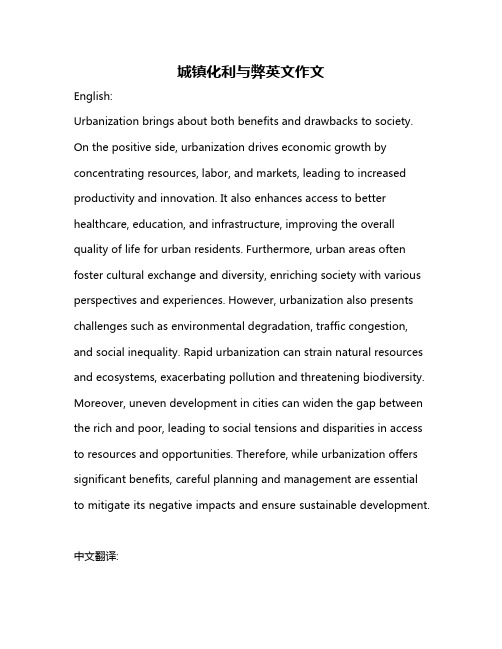
城镇化利与弊英文作文English:Urbanization brings about both benefits and drawbacks to society. On the positive side, urbanization drives economic growth by concentrating resources, labor, and markets, leading to increased productivity and innovation. It also enhances access to better healthcare, education, and infrastructure, improving the overall quality of life for urban residents. Furthermore, urban areas often foster cultural exchange and diversity, enriching society with various perspectives and experiences. However, urbanization also presents challenges such as environmental degradation, traffic congestion, and social inequality. Rapid urbanization can strain natural resources and ecosystems, exacerbating pollution and threatening biodiversity. Moreover, uneven development in cities can widen the gap between the rich and poor, leading to social tensions and disparities in access to resources and opportunities. Therefore, while urbanization offers significant benefits, careful planning and management are essential to mitigate its negative impacts and ensure sustainable development.中文翻译:城镇化对社会既带来了好处,也存在着不利之处。
城市化的利弊 英语作文
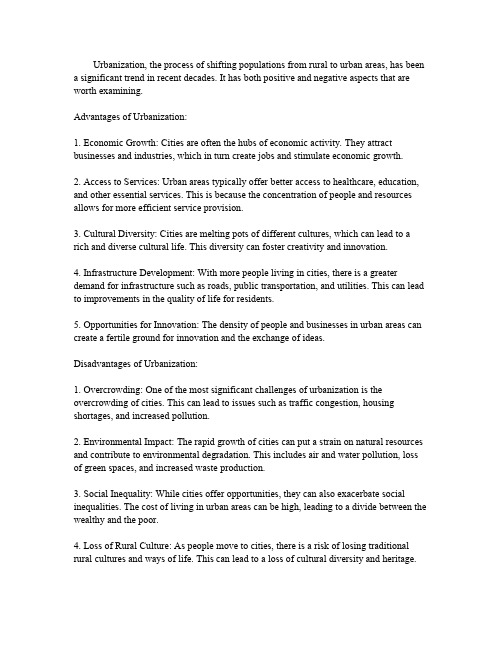
Urbanization,the process of shifting populations from rural to urban areas,has been a significant trend in recent decades.It has both positive and negative aspects that are worth examining.Advantages of Urbanization:1.Economic Growth:Cities are often the hubs of economic activity.They attract businesses and industries,which in turn create jobs and stimulate economic growth.2.Access to Services:Urban areas typically offer better access to healthcare,education, and other essential services.This is because the concentration of people and resources allows for more efficient service provision.3.Cultural Diversity:Cities are melting pots of different cultures,which can lead to a rich and diverse cultural life.This diversity can foster creativity and innovation.4.Infrastructure Development:With more people living in cities,there is a greater demand for infrastructure such as roads,public transportation,and utilities.This can lead to improvements in the quality of life for residents.5.Opportunities for Innovation:The density of people and businesses in urban areas can create a fertile ground for innovation and the exchange of ideas.Disadvantages of Urbanization:1.Overcrowding:One of the most significant challenges of urbanization is the overcrowding of cities.This can lead to issues such as traffic congestion,housing shortages,and increased pollution.2.Environmental Impact:The rapid growth of cities can put a strain on natural resources and contribute to environmental degradation.This includes air and water pollution,loss of green spaces,and increased waste production.3.Social Inequality:While cities offer opportunities,they can also exacerbate social inequalities.The cost of living in urban areas can be high,leading to a divide between the wealthy and the poor.4.Loss of Rural Culture:As people move to cities,there is a risk of losing traditional rural cultures and ways of life.This can lead to a loss of cultural diversity and heritage.5.Health Issues:Urban living can also be associated with certain health issues,such as stress and lifestylerelated diseases,due to factors like pollution and sedentary lifestyles.In conclusion,urbanization is a complex phenomenon with both benefits and drawbacks. It is essential for policymakers to carefully consider these aspects when planning urban development to ensure that cities can grow in a sustainable and inclusive manner.This includes addressing issues like housing,transportation,and social services to create cities that are not only economically vibrant but also livable and equitable for all residents.。
城市化的优缺点和自己的观点英语作文
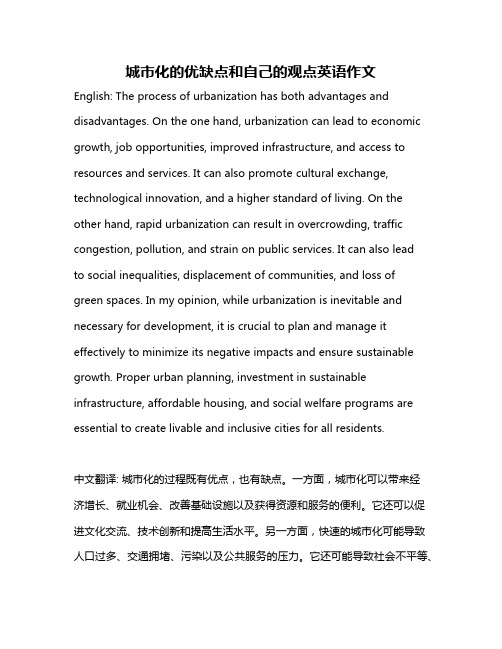
城市化的优缺点和自己的观点英语作文English: The process of urbanization has both advantages and disadvantages. On the one hand, urbanization can lead to economic growth, job opportunities, improved infrastructure, and access to resources and services. It can also promote cultural exchange, technological innovation, and a higher standard of living. On the other hand, rapid urbanization can result in overcrowding, traffic congestion, pollution, and strain on public services. It can also leadto social inequalities, displacement of communities, and loss of green spaces. In my opinion, while urbanization is inevitable and necessary for development, it is crucial to plan and manage it effectively to minimize its negative impacts and ensure sustainable growth. Proper urban planning, investment in sustainable infrastructure, affordable housing, and social welfare programs are essential to create livable and inclusive cities for all residents.中文翻译: 城市化的过程既有优点,也有缺点。
城镇化的好坏英文作文
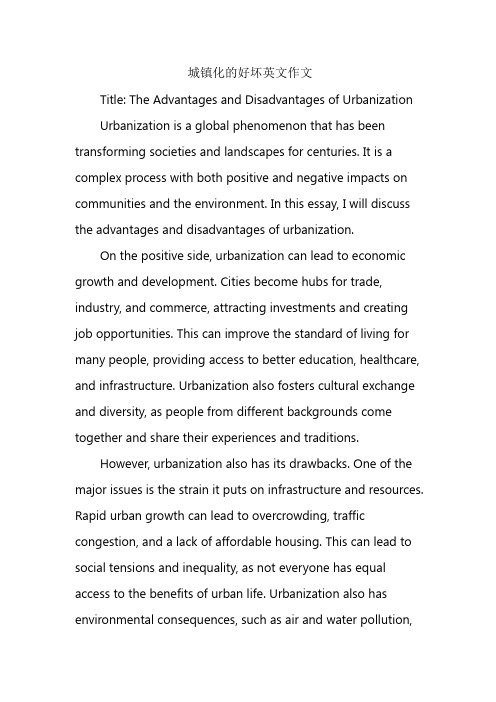
城镇化的好坏英文作文Title: The Advantages and Disadvantages of UrbanizationUrbanization is a global phenomenon that has been transforming societies and landscapes for centuries. It is a complex process with both positive and negative impacts on communities and the environment. In this essay, I will discuss the advantages and disadvantages of urbanization.On the positive side, urbanization can lead to economic growth and development. Cities become hubs for trade, industry, and commerce, attracting investments and creating job opportunities. This can improve the standard of living for many people, providing access to better education, healthcare, and infrastructure. Urbanization also fosters cultural exchange and diversity, as people from different backgrounds come together and share their experiences and traditions.However, urbanization also has its drawbacks. One of the major issues is the strain it puts on infrastructure and resources. Rapid urban growth can lead to overcrowding, traffic congestion, and a lack of affordable housing. This can lead to social tensions and inequality, as not everyone has equal access to the benefits of urban life. Urbanization also has environmental consequences, such as air and water pollution,loss of green spaces, and increased energy consumption.In conclusion, urbanization is a double-edged sword. While it brings economic growth and cultural exchange, it also poses challenges in terms of infrastructure, resources, and the environment. It is crucial that policymakers and urban planners address these issues and work towards creating sustainable and inclusive cities that can benefit everyone.中文翻译:标题:城镇化的好坏城镇化是一个已经影响社会和景观数千年的全球现象。
中国城市化进程的好处和坏处英语作文
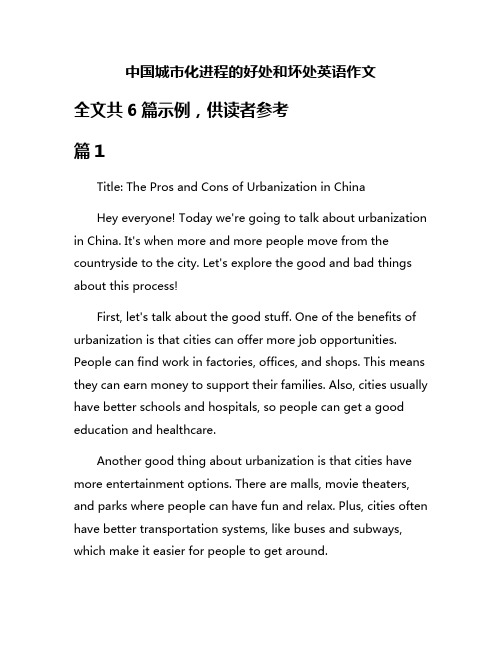
中国城市化进程的好处和坏处英语作文全文共6篇示例,供读者参考篇1Title: The Pros and Cons of Urbanization in ChinaHey everyone! Today we're going to talk about urbanization in China. It's when more and more people move from the countryside to the city. Let's explore the good and bad things about this process!First, let's talk about the good stuff. One of the benefits of urbanization is that cities can offer more job opportunities. People can find work in factories, offices, and shops. This means they can earn money to support their families. Also, cities usually have better schools and hospitals, so people can get a good education and healthcare.Another good thing about urbanization is that cities have more entertainment options. There are malls, movie theaters, and parks where people can have fun and relax. Plus, cities often have better transportation systems, like buses and subways, which make it easier for people to get around.But urbanization also has some drawbacks. One of the problems is that cities can become very crowded. This can lead to traffic jams, pollution, and even diseases spreading more easily. Also, as more people move to the cities, the cost of living can go up, making it harder for some people to afford food and housing.Another downside of urbanization is that it can lead to the loss of traditional culture. When people move to the cities, they might forget about their traditions and customs from the countryside. This can be sad because it's important to remember where we come from.In conclusion, urbanization in China has its good and bad points. It can provide people with better opportunities and a higher quality of life, but it can also bring challenges like overcrowding and the loss of culture. It's important for us to weigh these factors carefully and work together to create sustainable and inclusive cities for everyone. Thanks for listening!篇2The Benefits and Drawbacks of Urbanization in ChinaHey everyone, today we are going to talk about the benefits and drawbacks of urbanization in China! Urbanization meansmore and more people are moving from the countryside to the city. Let's see what's good and what's not so good about this!First, let's talk about the good stuff. One big benefit of urbanization is more job opportunities. In the city, there are lots of different jobs you can do, like working in offices, restaurants, or shops. This means people can make more money and have a better life.Another good thing about urbanization is better education. Cities usually have better schools and more resources for students. This means kids can get a good education and have a better chance at a successful future.But urbanization also has some drawbacks. One big problem is overcrowding. When too many people move to the city, it can get really crowded and there might not be enough space for everyone. This can lead to traffic jams, pollution, and other issues.Another downside of urbanization is the gap between rich and poor. In the city, there are a lot of rich people with fancy cars and big houses. But there are also a lot of poor people who struggle to make ends meet. This can create inequality and social issues.In conclusion, urbanization in China has both benefits and drawbacks. It's important for the government to manage the process carefully to make sure everyone can enjoy the benefits without facing too many drawbacks. Let's hope for a brighter future for all!篇3Title: The Benefits and Drawbacks of Urbanization in ChinaHey everyone! Today I'm going to talk about the good and bad things about cities getting bigger and more crowded in China. It's called urbanization, and it's a big deal!First, let's talk about the good things. One benefit of urbanization is that more jobs are available in cities. That's because lots of companies and businesses are located there. This means more opportunities for people to find work and earn money to support their families.Another good thing about urbanization is that cities have more advanced facilities and services. For example, there are better schools, hospitals, and transportation systems in cities. This makes life more convenient for people living there.Also, cities are centers of culture and entertainment. There are museums, theaters, sports stadiums, and more fun things to do in the city. People can enjoy a rich cultural life and have access to various forms of entertainment.However, there are also some drawbacks to urbanization. One downside is that cities can be very crowded and polluted. There are so many people and cars in the city that the air and water can become dirty. This can harm people's health and the environment.Another drawback of urbanization is that it can lead to a loss of traditional culture and community. As cities grow, old neighborhoods and buildings may be torn down to make way for new skyscrapers and shopping malls. This can erase the history and charm of a place.Additionally, urbanization can create social problems like poverty and inequality. Not everyone in the city may benefit from the economic growth and development. Some people may be left behind without access to basic necessities like housing and healthcare.In conclusion, urbanization in China has its benefits and drawbacks. It's important for the government and people to work together to ensure that cities develop in a sustainable andbalanced way. That way, everyone can enjoy the advantages of urban life while minimizing the negative impacts. Let's make our cities better places for everyone!篇4Hey guys, do you know what urbanization means? It's when more and more people move from rural areas to cities. In China, urbanization has been happening really fast, and there are both good things and bad things about it.One good thing is that cities have more job opportunities. When people move to cities, they can find work in factories, offices, and other places. This means they can earn more money to support their families. Also, cities usually have better schools, hospitals, and transportation systems, which make life more convenient for everyone.But urbanization also has some bad effects. One of them is pollution. In cities, there are more cars, factories, and buildings, which can create a lot of pollution. This can harm people's health and damage the environment. Also, as more people move to cities, there can be overcrowding and a lack of affordable housing. Some people may struggle to find a place to live or to afford basic necessities.However, the government is trying to manage the process of urbanization better. They are building more green spaces, improving public transportation, and controlling pollution. This can help make cities cleaner, safer, and more livable for everyone.In conclusion, urbanization in China has both good and bad sides. It's important for the government and people to work together to make cities better places to live. Let's all do our part to protect the environment and build a happy, healthy future for everyone.篇5China is becoming more and more urbanized. It has both benefits and drawbacks.First of all, urbanization brings a lot of advantages. One of the benefits is that it promotes economic development. Cities are centers of commerce and industry, and people living in urban areas have more job opportunities. As a result, their incomes increase and their living standards improve. In addition, urbanization also leads to better infrastructure, such as roads, bridges, and public transportation systems. This makes it easierfor people to travel and commute, which in turn boosts productivity and efficiency.On the other hand, urbanization also has its downsides. One of the main drawbacks is the strain it puts on the environment. As cities grow, they consume more resources, produce more waste, and emit more pollution. This can lead to air and water pollution, deforestation, and loss of biodiversity. In addition, rapid urbanization can also result in social problems, such as overcrowding, poverty, and crime. Furthermore, as more people move to cities, rural areas are left behind, leading to a growing wealth gap between urban and rural areas.In conclusion, China's urbanization process has both advantages and disadvantages. It is important for the government to carefully manage the process to maximize the benefits and minimize the drawbacks. By investing in sustainable development, improving infrastructure, and implementing policies to protect the environment, China can ensure that urbanization benefits everyone in the long run.篇6Hey guys, today I want to talk about the benefits and drawbacks of urbanization in China. So, let's get started!First of all, let's talk about the good stuff. One of the advantages of urbanization is that it brings more job opportunities. When cities grow, more businesses open up, which means more jobs for people. This is great because it helps reduce unemployment and improve people's living standards.Another benefit is better infrastructure. In big cities, there are more roads, schools, hospitals, and other public facilities. This makes it easier for people to get around and access the services they need. Plus, urban areas often have better access to technology and innovation, which can lead to advancements in various fields.However, urbanization also has its drawbacks. One of the biggest issues is pollution. As cities grow, so does the amount of pollution they produce. This can have a negative impact on people's health and the environment. Traffic congestion is also a problem in many cities, leading to longer commutes and increased stress for residents.Another downside of urbanization is the growing wealth gap. In big cities, there are often wealthy neighborhoods and poor neighborhoods right next to each other. This can lead to social tensions and inequality, with some people having better access to resources and opportunities than others.Overall, urbanization in China has both its pros and cons. It's important for the government and city planners to find a balance between economic growth and social well-being to ensure sustainable development in the future. Let's hope they can figure it out soon!That's all for today, guys. Thanks for listening!。
城市化的利弊大学英语作文
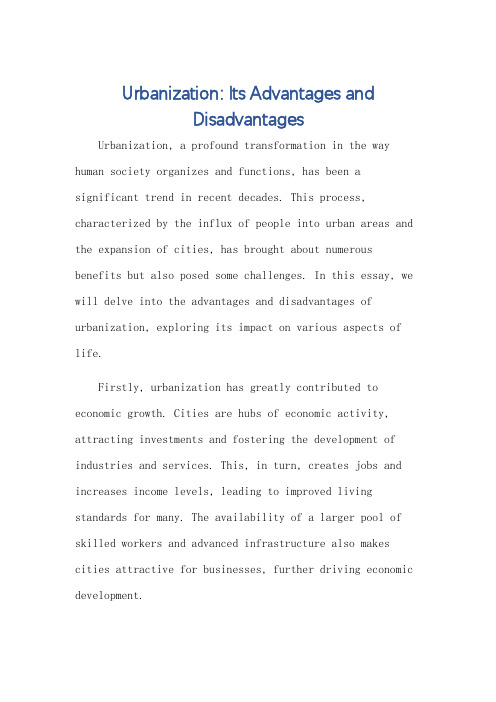
Urbanization: Its Advantages andDisadvantagesUrbanization, a profound transformation in the way human society organizes and functions, has been a significant trend in recent decades. This process, characterized by the influx of people into urban areas and the expansion of cities, has brought about numerous benefits but also posed some challenges. In this essay, we will delve into the advantages and disadvantages of urbanization, exploring its impact on various aspects of life.Firstly, urbanization has greatly contributed to economic growth. Cities are hubs of economic activity, attracting investments and fostering the development of industries and services. This, in turn, creates jobs and increases income levels, leading to improved living standards for many. The availability of a larger pool of skilled workers and advanced infrastructure also makes cities attractive for businesses, further driving economic development.Moreover, urbanization enhances social and cultural diversity. As people migrate to cities from diverse backgrounds, they bring their unique cultures, traditions, and ideas, enriching the social fabric of the urban community. This diversity fosters creativity, innovation, and tolerance, making cities vibrant and dynamic places to live in.However, despite its benefits, urbanization also brings about some significant disadvantages. One of the most pressing issues is the strain on infrastructure and resources. As cities expand, the demand for housing, transportation, water, and electricity increases, often exceeding the supply. This leads to overcrowding, traffic congestion, and environmental degradation, affecting the quality of life in urban areas.Furthermore, urbanization often leads to social inequality and exclusion. The influx of migrants and the high cost of living in cities can create significant disparities in income and opportunities. This can lead to the marginalization of certain groups, such as the poor,ethnic minorities, or immigrants, who may face discrimination and exclusion from the mainstream society. Lastly, urbanization can have negative impacts on the environment. The expansion of cities often results in the loss of green spaces and natural habitats, leading to biodiversity loss and ecological imbalance. Air and noise pollution, caused by industrialization and increased vehicular traffic, also pose serious health risks to urban residents.In conclusion, urbanization is a complex process that brings about both positive and negative impacts. While it contributes significantly to economic growth and social diversity, it also poses challenges in terms of infrastructure, resources, social inequality, and environmental degradation. It is, therefore, crucial for policymakers and urban planners to strike a balance between urban development and sustainability, ensuring that the benefits of urbanization are shared by all and its negative impacts are minimized.**城市化的利弊**城市化是人类社会组织与功能发生深刻变革的重要趋势,近几十年来尤为显著。
城镇化的好坏英文作文
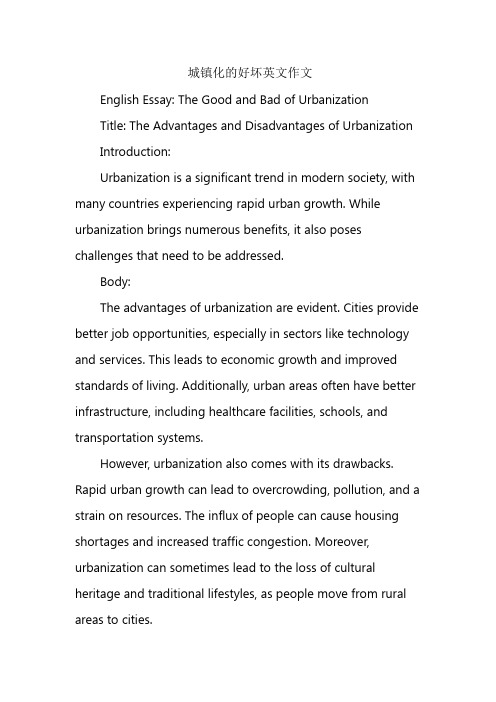
城镇化的好坏英文作文English Essay: The Good and Bad of UrbanizationTitle: The Advantages and Disadvantages of Urbanization Introduction:Urbanization is a significant trend in modern society, with many countries experiencing rapid urban growth. While urbanization brings numerous benefits, it also poses challenges that need to be addressed.Body:The advantages of urbanization are evident. Cities provide better job opportunities, especially in sectors like technology and services. This leads to economic growth and improved standards of living. Additionally, urban areas often have better infrastructure, including healthcare facilities, schools, and transportation systems.However, urbanization also comes with its drawbacks. Rapid urban growth can lead to overcrowding, pollution, and a strain on resources. The influx of people can cause housing shortages and increased traffic congestion. Moreover, urbanization can sometimes lead to the loss of cultural heritage and traditional lifestyles, as people move from rural areas to cities.Conclusion:In conclusion, urbanization has both positive and negative aspects. While it brings economic growth and improved infrastructure, it also poses challenges such as overcrowding and the loss of cultural heritage. It is important for governments and communities to work together to address these challenges and ensure that urbanization benefits everyone.中文翻译:城镇化的好处与坏处标题:城镇化的优点与缺点介绍:城镇化是现代社会的一个显著趋势,许多国家正在经历快速的城市增长。
关于城市化的英语作文利弊范文
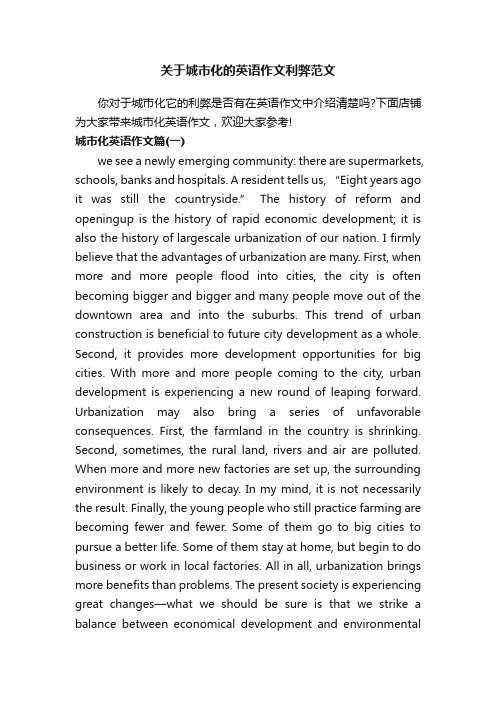
关于城市化的英语作文利弊范文你对于城市化它的利弊是否有在英语作文中介绍清楚吗?下面店铺为大家带来城市化英语作文,欢迎大家参考!城市化英语作文篇(一)we see a newly emerging community: there are supermarkets, schools, banks and hospitals. A resident tells us, “Eight years ago it was still the countryside.” The history of reform and openingup is the history of rapid economic development; it is also the history of largescale urbanization of our nation. I firmly believe that the advantages of urbanization are many. First, when more and more people flood into cities, the city is often becoming bigger and bigger and many people move out of the downtown area and into the suburbs. This trend of urban construction is beneficial to future city development as a whole. Second, it provides more development opportunities for big cities. With more and more people coming to the city, urban development is experiencing a new round of leaping forward. Urbanization may also bring a series of unfavorable consequences. First, the farmland in the country is shrinking. Second, sometimes, the rural land, rivers and air are polluted. When more and more new factories are set up, the surrounding environment is likely to decay. In my mind, it is not necessarily the result. Finally, the young people who still practice farming are becoming fewer and fewer. Some of them go to big cities to pursue a better life. Some of them stay at home, but begin to do business or work in local factories. All in all, urbanization brings more benefits than problems. The present society is experiencing great changes—what we should be sure is that we strike a balance between economical development and environmentalprotection.城市化英语作文篇(二)Urbanization has been a subject of heated discussion for a long time. Some people are in favor, while others are opposed. In my opinion, urbanization has both advantages and disadvantages.Generally, the advantages of urbanization can be listed as follows. First,urbanization can quicken our pace to catch up with the developed countries. We all know that the developed countries are all highly urbanized. Second, urbanization will help to solve the problem of unemployment. It will create more job opportunities for the unemployed. In addition, urbanization will free a great number of farmers from the fields, thus realizing the dream of agricultural mechanization in our country. Finally, urbanization can improve the standards of living of the migrants who move to the urban area.However,the disadvantages of urbanization are also obvious. To begin with,administration of the increasing population in urban area might be a great challenge to the government. Moreover, more problems, such as increasing crime rate, over crowding, might increase, since more people are concentrated in a relatively smaller place.It is evident that the advantages outweigh the disadvantages. Therefore, I am in favor of urbanization.城市化英语作文篇(三)Presently, there is a tendency that a growing number of people are moving from countryside into city annually. A century ago, less than five percent of all people lived in cities. By the middle of this century it could be seventy percent, or almost six and a half billion people.Urbanization can lead to social and economic progress, but also put pressure on cities to provide housing and services. With the increasing number of individuals pouring into cities, the worsening inequalities, driven by social divisions and differences in wealth, could result in violence and crime unless cities plan better. Another issue is urban expansion. This is where cities expand quickly into rural areas, sometimes at a much faster rate than urban population growth.From my perspective, the government is expected to implement laws and regulations to limit the exceedingly growing of the urban population. As college students, we can seek employment back to our hometown and I am sure a promising future is awaiting us there.城市化英语作文篇(四)With the development of economy, more and more people rush to cities. Some people rush to cities in order to look for jobs and earn more money while others want to learn new knowledge and improve the quality of their personal life.Opportunities for bright young people are greater in the cities.But there exist some problems. For example, owing to the increasing population,the housing and traffic problem are becoming more and more serious. And the rush of the country people to cities also leads to the rise in crimes.To solve these problems,the government should take effective measures to control the population and make them live orderly. Also some opportunities should be created for the country people to receive education and improve their quality of life.。
城镇化的缺点和优点的英语作文
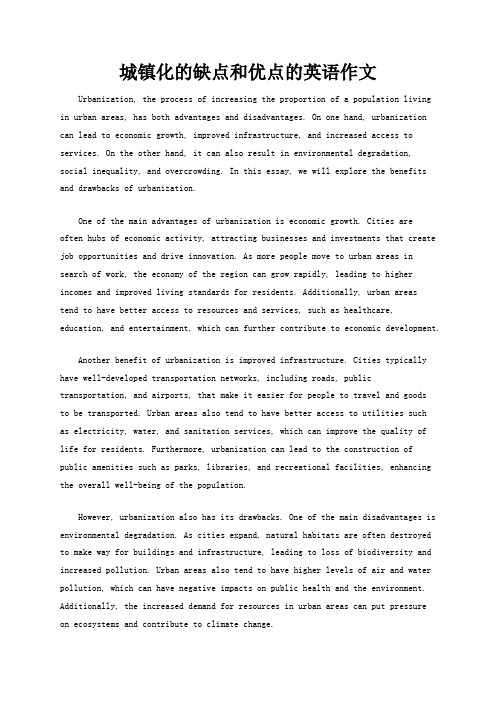
城镇化的缺点和优点的英语作文Urbanization, the process of increasing the proportion of a population living in urban areas, has both advantages and disadvantages. On one hand, urbanization can lead to economic growth, improved infrastructure, and increased access to services. On the other hand, it can also result in environmental degradation, social inequality, and overcrowding. In this essay, we will explore the benefits and drawbacks of urbanization.One of the main advantages of urbanization is economic growth. Cities are often hubs of economic activity, attracting businesses and investments that create job opportunities and drive innovation. As more people move to urban areas in search of work, the economy of the region can grow rapidly, leading to higher incomes and improved living standards for residents. Additionally, urban areas tend to have better access to resources and services, such as healthcare, education, and entertainment, which can further contribute to economic development.Another benefit of urbanization is improved infrastructure. Cities typically have well-developed transportation networks, including roads, public transportation, and airports, that make it easier for people to travel and goods to be transported. Urban areas also tend to have better access to utilities such as electricity, water, and sanitation services, which can improve the quality of life for residents. Furthermore, urbanization can lead to the construction of public amenities such as parks, libraries, and recreational facilities, enhancing the overall well-being of the population.However, urbanization also has its drawbacks. One of the main disadvantages is environmental degradation. As cities expand, natural habitats are often destroyed to make way for buildings and infrastructure, leading to loss of biodiversity and increased pollution. Urban areas also tend to have higher levels of air and water pollution, which can have negative impacts on public health and the environment. Additionally, the increased demand for resources in urban areas can put pressure on ecosystems and contribute to climate change.Social inequality is another downside of urbanization. While cities offer opportunities for economic advancement, they can also exacerbate existing inequalities. In many urban areas, there is a stark divide between the wealthy and the poor, with marginalized communities often living in overcrowded and underserved neighborhoods. This can lead to social unrest, crime, and other social problems that can undermine the overall well-being of the population. Furthermore, rapid urbanization can strain social services and infrastructure, leading to issues such as homelessness, inadequate housing, and lack of access to basic amenities.In conclusion, urbanization has both advantages and disadvantages. While it can contribute to economic growth, improved infrastructure, and better access to services, it can also result in environmental degradation, social inequality, and overcrowding. As cities continue to grow and evolve, it is important for policymakers to address these challenges and work towards creating sustainable, inclusive urban environments that benefit all residents.。
- 1、下载文档前请自行甄别文档内容的完整性,平台不提供额外的编辑、内容补充、找答案等附加服务。
- 2、"仅部分预览"的文档,不可在线预览部分如存在完整性等问题,可反馈申请退款(可完整预览的文档不适用该条件!)。
- 3、如文档侵犯您的权益,请联系客服反馈,我们会尽快为您处理(人工客服工作时间:9:00-18:30)。
城市化的利与弊英语作文
High rise buildings bring benefits as well as problems in the process of modernization and urbanization of large cities. In order to solve the housing problem, high-rise buildings have appeared in more and more big cities. High rise buildings have their own advantages and disadvantages.
Of course, in urban areas where land is expensive, they take up less space. Some people say that high-rise buildings can bring amazing beauty to the city. Some buildings are apartments, which can accommodate hundreds of families under a roof.
On the other hand, high-rise buildings can be very dangerous. What if there is a fire or an earthquake? In short, high-rise buildings are necessary We must take effective measures to solve the problems of water supply and power supply.
中文翻译:
在大城市的现代化和城市化进程中,高层建筑既带来了好处,也带来了问题。
为了解决住房问题,越来越多的大城市出现了并且正在出现越来越多的高层建筑。
高层建筑各有利弊。
当然,在土地昂贵的城市地区,它们占用的空间更少。
有人说,高楼大厦能给城市带来惊人的美丽。
有些建筑是公寓,可以在一个屋檐下容纳数百个家庭。
另一方面,高层建筑可能是危险的。
如果发生火灾或地震怎么办?总之,高层建筑是必要的,但同时,其数量也要有所限制。
必须采取有效措施解决供水、供电等问题。
